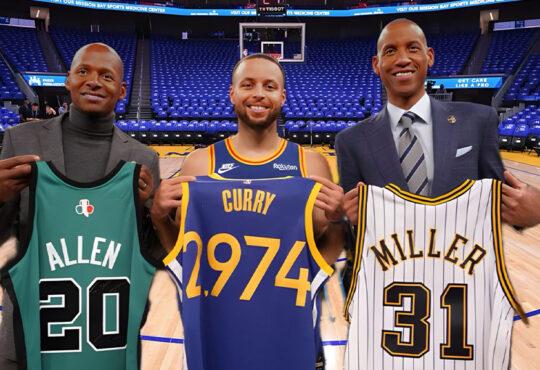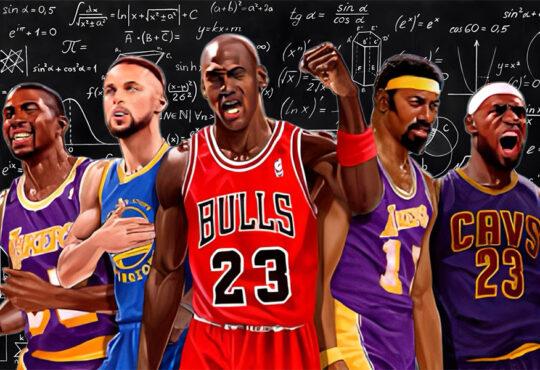
What Happens at the NBA Draft Combine?
What Happens at the NBA Draft Combine? The NBA Draft policy pursues the goal to provide the weakest teams with the most talented young players to close the gap to the superior competition. But it hinges on the appropriate talent evaluation skills of the respective organizations.
The NBA teams and scouts do not take anything for granted and before they chose to give a player a chance, he is examined in detail.
Each year, the upcoming NBA Draft prospects are put to the test both mentally and physically. These tests are supposed to determine if a player is at the top of their game and has the potential to take their team to the next level. The first step in that grueling process is the Draft Combine.
NBA combine traditionally has been a launching pad for NBA talent and a fairly good predictor of which players will be drafted that year. Over the past five seasons, an average of 43 of the NBA’s 60 draft picks were filled by players who participated in the NBA combine. Last year was a particularly good year for combine invitees: 49 of them heard their names on draft night.
The NBA Draft Combine is a multi-day showcase that takes place every May before the annual NBA draft that is usually organized in late June. At the combine, college and international basketball players are measured and take medical tests, are interviewed, perform various athletic tests and shooting drills, and play in five-on-five drills for an audience of NBA coaches, general managers, and scouts.
Each one of the players in the combine could get themselves a higher draft projection by having themselves a terrific combine performance. Whether you have incredible interviews or perform beautifully in some of the drills available, teams could think of you much higher than ever before after seeing you up close.
Securing an invite to the combine, however advantageous, is no guarantee that a player will be drafted. That’s mostly because NBA teams select an average of 10 international players each June who have never played a minute of college basketball. Those international players rarely attended the combine.
What measurements are taken?
One of the first steps in getting a player ready at the NBA Draft combine is getting all of their measurements sorted out. This usually comes alongside their medical history being checked over and looked at so that the player doesn’t seriously reinjure a previous sprain or fracture that they could have suffered earlier.
Among the measurements that are taken from each player are their height with shoes on, their height with shoes off, weight, wingspan, body fat, hand length, hand width, and standing reach. These measurements are highly regarded by coaches and staff because there is a certain threshold that players need to cross which has a correlation to future success.
For example, a long wingspan could help a player shoot over his defender more often. Then on the other end, that wingspan could be used to defend his matchup far more efficiently than other players can, making him more valuable. Another example would be body fat. If a player is way off from the recommended body fat at the time of his measurement, then teams would take that into account. 48 minutes of NBA basketball certainly takes a toll on your body, and being unconditioned isn’t something that teams want out of their players.
In 2013, Rudy Gobert set the Combine records for wingspan 7 feet 8.5 inches (2.35 m) and standing reach 9 feet 7 inches (2.92 m). Those records were later be broken in 2018 by Mo Bamba, and then by Tacko Fall a year later. Fall also became the tallest participant in event history at 7 feet 7 inches (2.31 m).
The Athletic Test
The athletic tests within the Draft Combine include a standing vertical jump, maximum vertical jump, bench press, three-quarter-court sprint time, lane agility time, and modified event time.
One of the most interesting physical tests that the prospects have to undergo and receive the most attention is the vertical leap.
In 2021, the max vertical leap was back among the headlines as Keon Johnson, a guard out of Tennessee, broke the all-time combine record.
He recorded a 48-inch vertical leap, comfortably breaking the previous record of 45.5 inches.
Top 10 players with the highest vertical leaps in Draft Combine history
| Year | Name | Height | Standing vertical leap | Max vertical leap |
| 2021 | Keon Johnson | 6’5″ | 41.5 | 48 |
| 2001 | Kenny Gregory | 6’5″ | 39.5 | 45.5 |
| 2017 | Hamidou Diallo | 6’5″ | 34.5 | 44.5 |
| 2021 | Jericho Sims | 6’10” | 37 | 44.5 |
| 2015 | Pat Connaughton | 6’5″ | 37.5 | 44 |
| 2016 | Kay Felder | 5’9″ | 35.5 | 44 |
| 2013 | Shane Larkin | 5’11” | 34.5 | 44 |
| 2020 | Cassius Stanley | 6’6″ | 34.5 | 44 |
| 2020 | Tyler Bey | 6’7″ | 37 | 43.5 |
Speed Test
Speed may not be the most important attribute for NBA prospects, but it’s certainly near the top, as there is tremendous value in players who can grab a rebound and fly down the court before the defense can set up.
That’s why players are tested for speed at the annual NBA Draft Combine using the three-quarter court sprint, measured in seconds.
10 fastest player at the NBA Draft combine in history
| Year | Name | Three-Quarter Sprint (seconds) |
| 2001 | Cookie Belcher | 2.91 |
| 2001 | Jason Gardner | 2.92 |
| 2004 | Nate Robinson | 2.96 |
| 2008 | Sonny Weems | 2.96 |
| 2021 | Scottie Lewis | 2.98 |
| 2008 | Joe Alexander | 2.99 |
| 2021 | Daishen Nix | 3 |
| 2020 | Schea Cotton | 3 |
| 2001 | SirValiant Brown | 3 |
| 2005 | Will Bynum | 3 |
| 2017 | Donovan Mitchell | 3.01 |
How Do Players Get Invited to the Combine?
It’s actually really difficult to get invited to the NBA combine. There are 60 players drafted every single season throughout two rounds. However, less than 100 prospects receive invitations to the combine every year. While that may seem like a lot, there are a ton of players every season that go undrafted.
The invitation list is determined by a vote of the member teams of the NBA. In 2013, 63 players were invited. 60 players were invited in 2014. The vast majority of players receiving invitations attend. In 2014, the top three candidates (Jabari Parker, Andrew Wiggins, and Joel Embiid) declined invitations and a few others (such as Mitch McGary and Adreian Payne) declined after receiving them or at least declined full participation, but 59 participants were expected. Each team is allowed a maximum of 18 official interviews during the combine.
There is immense competition to get a spot at one of these combines, but the NBA makes it clear that only the most distinctive athletes at the college basketball level will be able to get an invitation. Most recently, we just wrapped up the 2021-22 NBA Draft. It has been reported that only 69 players were able to get an invite to the combine this season. Some may overlook how difficult it is to get into the combine, but that shouldn’t ever be the case. We could even see the invitations being brought down even further in upcoming years.
For the players that aren’t able to get an invitation to this process, don’t panic. Sometimes players are able to contact the league office and get themselves an invitation if they have no other option. If that doesn’t work, the NBA G-League always offers a fresh start and new opportunities. Even going overseas to play for other leagues like the Spanish League, Australian Basketball League, and the Italian League.
NBA G League Elite Camp
Beginning from 2010, a D-League elite mini-camp lasting two days preceded the Combine. Beginning in 2016, players could enter the draft and participate in the combine multiple times. In 2019, the event was changed into the NBA G League Elite Camp, which became a three-day event showcasing both NBA draft hopefuls and elite NBA G League prospects. This event also allows a limited amount of draft prospects a chance to transfer into the NBA Draft Combine after the NBA G League Elite Camp concludes.
Kevin Durant recalls his participation at the NBA Draft Combine
Combine results may or may not affect draft position, depending on certain results from it. Supposedly, medical test results caused Jared Sullinger to fall to No. 21 in 2012, while Kevin Durant was drafted No. 2 in 2007 despite not being able to do a single repetition on the 185-pound (84 kg) bench press. Durant is not alone; Jamal Crawford, Monta Ellis, T. J. Ford, and Luke Ridnour are among the zero-rep producers.
The record is 27 reps by Jason Keep in 2003. In 2016, Tyler Ulis set the Combine record for being the lightest player to record his weight at the event, which is set at 149 pounds.
By this day Kevin Durant remembers his experience at the Draft Combine and despite the fact that he wasn’t the best player according to the measurements, he was aware that basketball is much more than that.
Now a four-time scoring champion Kevin Durant, apparently wished franchises focused on hoops abilities rather than measurables.
“I remember it like it was yesterday,” Durant says. “All the strength coaches were laughing at me and (stuff). They were giggling with each other that I couldn’t lift 185 pounds (on a bench press), and I was like, ‘All right, keep laughing. Keep laughing.’ It was a funny thing because I was the only one that couldn’t lift it and I was struggling to lift it. I was embarrassed at that point, but I’m like, ‘Give me a basketball, please. Give me a ball.”
Any fan of KD, a two-time NBA champion and 2104 NBA MVP knows why he simply wanted to show his stuff.
“I knew nobody in that draft could guard me one-on-one,” Durant said. “I knew that for sure. I knew that. And I knew that you don’t need to (bench-press) to lift a basketball up. And I knew that this wasn’t football, where that stuff matters. I knew as a basketball player I had a lot of skill, more skill than anybody in the draft. And I knew that if I worked as hard as I could, then that (stuff) wouldn’t matter at the end of the day. It still doesn’t matter. I was ranked the last person in camp, drills-wise. I was the worst player and the first player who didn’t get drafted. That tells you a lot about the significance of that (stuff).”
Thus, Durant had a suggestion for potential top prospects.
“Stay your ass home, work out and get better on your own time,” KD said. “Just work on your game, and then they’ll see you in the individual workouts, and they’ve been watching you all year, so your whole body of work is more important than just going there for a couple of days.”
Durant was selected No. 2 overall by the Seattle SuperSonics, who later became the Oklahoma City Thunder after the Trail Blazers picked big man Greg Oden.
“I figured they knew who they were going to draft already,” Durant said. “But that says a lot, as well. I was the No. 2 pick, and I couldn’t lift 185 pounds. That shows you that basketball isn’t really that type of sport.”
Asked if he can lift 185 pounds now, Durant has a funny answer.
“I haven’t tried. I know I can lift 185, though, now, but I don’t bench-press,” Durant told ESPN. “I don’t try to do max on the bench press. There’s no point in that. As I said, I knew I was the most skilled player there,” Durant said. “I knew I was the best player in the draft. I knew my skill set was a little different from everybody else and (they) couldn’t guard me. (They) still can’t.”







